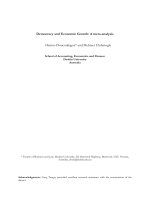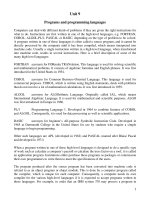101 COLOR AND SHAPES ACTIVITIES pdf
Bạn đang xem bản rút gọn của tài liệu. Xem và tải ngay bản đầy đủ của tài liệu tại đây (1.86 MB, 82 trang )
ISBN 1-57029-487-9
WPH99029
Teacher Resource
• Includes 101 Ideas
for Teaching Colors
and Shapes
• Spans Multiple
Curriculum
Areas
• Activities
Individually
Numbered
and Titled
• Supports Popular
Kindergarten
Standards
Ages
3-6
Visit our Web site at
www.MHteachers.com
Colors and shapes are essential components of the
early childhood curriculum. They form a foundation for
geometry, patterning, and a variety of visual and spatial
skills. In this book you will find endless opportunities to
extend and reinforce these concepts throughout the
day. You will find activities to foster children’s social
and emotional development, build language and
literacy skills, and develop an understanding of math
concepts. You will also find science activities that
strengthen children’s observation and reasoning skills,
music and movement activities that get everyone
involved, and group art activities that inspire creativity
and cooperation. An Early Childhood Standards
Correlation Chart is included to help you quickly identify
activities that focus on a specific skill. The ideas in this
book are only the beginning. Enjoy!
See a page-by-page summary of each
product that meets your
state Standards.
State Standards
TeachingStateStandards.com
➔Select your state ➔subject ➔grade
MEETS
YOUR
This Book
Ages 3–6
By
Susan Hodges
Illustrations by
Gary Mohrman
Published by Totline
®
Publications
an imprint of
101
ACTIVITIES
Published by Totline
®
Publications
An imprint of School Specialty Publishing
Copyright © 2004 School Specialty Publishing
All Rights Reserved • Printed in the United States of America
No part of this publication may be reproduced, stored in a retrieval system, or transmitted, in any form or by any means,
electronic, mechanical, photocopying, recording, or otherwise, without the prior written permission of the publisher.
Send all inquiries to:
School Specialty Publishing
3195 Wilson Drive NW
Grand Rapids, Michigan 49534
101 Colors and Shapes Activities—Ages 3–6
ISBN: 1-57029-487-9
1 2 3 4 5 6 7 8 9 MAL 09 08 07 06 05 04
Author: Susan Hodges
© McGraw-Hill Children’s Publishing
1-57029-487-9 101 Colors and Shapes Activities
3
TABLE OF CONTENTS
Early Childhood Standards
Correlation . . . . . . . . . . . . 4
Introduction . . . . . . . . . . . . . 6
Social and Emotional
Development . . . . . . . . . . . 7
Crayon Poster . . . . . . . . . . . . . . 7
Shape Sandwiches. . . . . . . . . . . 8
Here’s My Shape . . . . . . . . . . . . 9
Color Day. . . . . . . . . . . . . . . . . 10
Breakfast Talk. . . . . . . . . . . . . 10
Colorful Feelings . . . . . . . . . . . 11
Find a Partner . . . . . . . . . . . . . 12
Name the Missing Shape. . . . . 13
Language and Literacy . . . . 14
The Story of a Circle . . . . . . . . 14
Anytime Egg Hunt. . . . . . . . . . 15
Who Can Find It?. . . . . . . . . . . 15
Parking Garage . . . . . . . . . . . . 16
Scarf Pull. . . . . . . . . . . . . . . . . 16
I Spy . . . . . . . . . . . . . . . . . . . . 17
There’s a Word for That . . . . . 18
Wheel Walk . . . . . . . . . . . . . . . 19
Color Story . . . . . . . . . . . . . . . 19
Big Book Time. . . . . . . . . . . . . 20
Color Journal . . . . . . . . . . . . . . 21
The Crayon I’m Holding . . . . . 22
Math . . . . . . . . . . . . . . . . . . 23
Green Things. . . . . . . . . . . . . . 23
Crayon Match-Up. . . . . . . . . . . 24
In the Doghouse . . . . . . . . . . . 24
Colorful Block Tower. . . . . . . . 25
Flannelboard Train . . . . . . . . . 26
Match It. . . . . . . . . . . . . . . . . . 26
Itty-Bitty Sorter. . . . . . . . . . . . 27
Paint Sample Matching . . . . . . 27
Block Play . . . . . . . . . . . . . . . . 28
Circle Sort . . . . . . . . . . . . . . . . 28
Secret Shapes . . . . . . . . . . . . . 29
Take-Home Flannelboard Kit. . 29
Sandpaper Shapes . . . . . . . . . . 30
Shape Picture Cards . . . . . . . . 30
Shoe Sort. . . . . . . . . . . . . . . . . 31
Treasure Maps. . . . . . . . . . . . . 31
Neighborhood Picture Book
. . . 32
Do What I Do . . . . . . . . . . . . . 32
Science . . . . . . . . . . . . . . . . 33
Food Color Chart . . . . . . . . . . . 33
Shaker Bottle . . . . . . . . . . . . . 34
Something Blue . . . . . . . . . . . . 35
Apple Exploration . . . . . . . . . . 35
Make a Rainbow . . . . . . . . . . . 36
Bubbles Everywhere . . . . . . . . 36
Studying Leaves . . . . . . . . . . . 37
Mixing Tints . . . . . . . . . . . . . . 38
Color Goo. . . . . . . . . . . . . . . . . 39
Rainbow Pudding . . . . . . . . . . 40
Light Show . . . . . . . . . . . . . . . 41
Rolling Along . . . . . . . . . . . . . 42
Sun Prints . . . . . . . . . . . . . . . . 43
Tinted Ice Cubes . . . . . . . . . . . 43
Music and Movement. . . . . . 44
Some Shoes . . . . . . . . . . . . . . . 44
Color Train. . . . . . . . . . . . . . . . 45
Flag March . . . . . . . . . . . . . . . 46
If Your Clothes Have
Any Red. . . . . . . . . . . . . . . . 47
Here We Go . . . . . . . . . . . . . . . 48
Do You Know What Shape
This Is? . . . . . . . . . . . . . . . . 49
Color Binoculars . . . . . . . . . . . 50
Red Light, Green Light . . . . . 51
Body Shapes . . . . . . . . . . . . . . 52
Read the Notes . . . . . . . . . . . . 52
Circle Gets the Square . . . . . . 53
The Shapes Are on the Floor
. . 54
Visual Arts . . . . . . . . . . . . . 55
Recycled Rainbow . . . . . . . . . . 55
Shape Prints . . . . . . . . . . . . . . 56
Counting Collage . . . . . . . . . . . 56
Marvelous Mobiles . . . . . . . . . 57
Shape Flags. . . . . . . . . . . . . . . 57
Shape Mural . . . . . . . . . . . . . . 58
Craft Stick Shapes. . . . . . . . . . 58
Motor Mural . . . . . . . . . . . . . . 59
Paper Bag Puppets . . . . . . . . . 59
Bubbly Paint . . . . . . . . . . . . . . 60
Sun Catcher. . . . . . . . . . . . . . . 60
Colored Sand . . . . . . . . . . . . . . 61
My Own Color Banner . . . . . . . 62
Dramatic Play . . . . . . . . . . . 63
Blanket Fold . . . . . . . . . . . . . . 63
Under the Sea . . . . . . . . . . . . . 64
Color Photography. . . . . . . . . . 64
The Ice Cream Shop . . . . . . . . 65
Special Delivery. . . . . . . . . . . . 65
The Flower Market . . . . . . . . . 66
Motor Skills . . . . . . . . . . . . 67
Get into Shape. . . . . . . . . . . . . 67
Just Like Me . . . . . . . . . . . . . . 68
Out the Door . . . . . . . . . . . . . . 69
Color Thumbkin. . . . . . . . . . . . 70
Shape Toss . . . . . . . . . . . . . . . 71
Finger Dance . . . . . . . . . . . . . . 71
Moving Shapes . . . . . . . . . . . . 72
Roll a Triangle. . . . . . . . . . . . . 73
Nail Shapes . . . . . . . . . . . . . . . 73
Color Matching Board . . . . . . . 74
Connect the Colors . . . . . . . . . 74
I Can Make a Circle. . . . . . . . . 75
Shape Sewing Cards . . . . . . . . 76
Rainbow Fruit Salad . . . . . . . . 77
String Shapes . . . . . . . . . . . . . 78
Dough Shapes . . . . . . . . . . . . . 78
Color Mixing . . . . . . . . . . . . . . 79
Pom-pom Sort . . . . . . . . . . . . . 80
© School Specialty Publishing
© McGraw-Hill Children’s Publishing
1-57029-487-9 101 Colors and Shapes Activities
4
EARLY CHILDHOOD
Early Childhood Standards Correlation Activity
1. Social and Emotional Development
a. Seeks to be independent and recognizes own unique abilities. Shows 1, 2, 3
perseverance and resiliency.
b. Shows respect for self, others, and property. 4
c. Demonstrates proper care of their body. 2, 5
d. Demonstrates an increasing awareness of and ability to control his or her 6
emotions in age-appropriate ways.
e. Is aware of own needs and is sensitive to those of others. Wants to be 5,10
understood and understands others.
f. Demonstrates a desire to learn and explore. Shows interest in the world 6, 16, 45, 49, 61
and people in his or her environment.
g. Is interested in interacting with others and participates in activities and 3, 4, 7, 8, 49, 65, 73, 83
discussions. Expresses needs and wants appropriately.
h. Listens well and follows rules. 60, 84, 85, 86, 90, 95, 97
2. Language and Literacy
a. Uses language to tell stories and share information while maintaining 9, 10, 11, 18
a topic. Can retell stories and events.
b. Develops oral language skills. Speaks understandably using most rules 12
of grammar.
c. Demonstrates appropriate language. 12, 13, 14
d. Uses a variety of vocabulary words to share concepts, experiences, 14, 15, 16, 83
and feelings.
e. Develops oral language by listening actively. Uses prior knowledge to make 17
predictions and construct meaning.
f. Demonstrates an enjoyment of and understanding of the importance of 9, 11, 18
reading. Understands concept of print.
g. Becomes familiar with and identifies letters and letter names. 19
h. Begins to use print concepts to write text. 13, 15, 19
i. Begins to develop phonemic awareness. 20
3. Math
a. Develops an understanding of numerals in the environment, including 25, 39, 67, 70, 78, 81
matching, counting, and grouping. Understands what
numbers represent.
b. Begins to understand simple shape concepts and can recognize and 3, 8, 29, 30, 31, 32, 33, 34
identify shapes in the environment.
c.
Is able to make comparisons and understands the concept of measurement.
35, 36
© School Specialty Publishing
© McGraw-Hill Children’s Publishing
1-57029-487-9 101 Colors and Shapes Activities
5
STANDARDS CORRELATION
Early Childhood Standards Correlation Activity
d. Understands patterns and their relationships. Is able to use this information 25, 27, 28, 29, 34, 37, 38
to construct meaning about the world and make predictions.
e. Develops visual discrimination skills. 21, 22, 23, 24, 26, 27, 28, 30
4. Science
a. Communicates observations and explorations. Shares information in a 39, 40, 41, 42, 43, 44, 45
variety of ways.
b. Demonstrates and develops a sense of curiosity about the world through 39, 40, 41, 44, 46, 47, 48, 49, 50,
observation and participation in activities of exploration and discovery. 51, 52
c. Makes connections and comparisons, and notices patterns and processes 42, 43, 45, 46, 52
in the environment.
5. Music and Movement
a. Participates in a variety of musical activities. Creates music through 53, 62
experimentation and improvisation with a variety of musical instruments.
b. Participates in dance and creative movement. 54, 55, 57
c. Explores own voice as musical instrument. Understands body is needed to 56, 57, 58, 59
use instruments and participates in musical creation.
d. Uses movement to understand new concepts. 54, 55, 56, 58, 60, 61, 63
6. Visual Arts
a. Recognizes colors and forms. 28, 65, 66, 67, 68, 69, 70, 71
b. Can put shapes and lines together to create a design. 65, 66, 67, 69, 72, 73
c. Uses a variety of art media and develops art skills through experimentation 68, 70, 71, 72, 73, 74, 75, 76, 77
and exploration using a variety of materials and processes.
7. Dramatic Play
a. Develops positive sense of self through participation in dramatic play 78, 79, 80, 81, 82, 83
activities. Explores emotions, relationships, and imagination.
Acts out a variety of roles.
8. Motor Skills
a. Develops age-appropriate gross motor skills. Demonstrates a sense of 84, 85, 86
balance and progression of locomotion skills.
b. Develops age-appropriate perceptual motor skills. Demonstrates 87, 88, 89, 90
knowledge of parts of the body and direction of movement.
Demonstrates understanding of directional vocabulary.
c. Uses age-appropriate gross manipulative skills. Develops skills in 88, 91
catching and throwing.
d. Develops fine-motor skills and eye-hand coordination. 87, 89, 92, 93, 94, 95, 96, 97, 98,
99, 100, 101
© School Specialty Publishing
© McGraw-Hill Children’s Publishing
1-57029-487-9 101 Colors and Shapes Activities
6
INTRODUCTION
Colors and shapes are essential components of the early childhood curriculum. They form a foundation for
geometry, patterning, and a variety of visual and spatial skills. As children see these concepts reflected in
the world around them, they become enthusiastic and engaged learners.
101 Colors and Shapes Activities is divided into eight chapters, each one reflecting an early childhood
curriculum area. You will find activities to foster the children’s social and emotional development,
language and literacy skills, and understanding of math concepts. You will also find science activities that
strengthen the children’s observation and reasoning skills, music and movement activities that get
everyone involved, and group art activities that inspire creativity and cooperation. There are also activities
for group dramatic play and activities to help children develop their fine and large motor skills. An Early
Childhood Standards Correlation on pages 4 and 5 will help you quickly identify activities when focus on
a specific skill is desired.
Young children love colors and shapes—and you will find endless opportunities for extending and
reinforcing these concepts throughout the day. The ideas in 101 Colors and Shapes Activities are only
the beginning.
© School Specialty Publishing
© McGraw-Hill Children’s Publishing
1-57029-487-9 101 Colors and Shapes Activities
7
1 CRAYON POSTER
Materials
Poster board
Scissors
Drawing supplies
Collage materials
Glue
Activity
When your group is learning a new color, invite them to make a group poster to build collaborative skills
and reinforce color concepts. Cut a large crayon shape out of poster board. Set out art supplies such as
crayons and collage materials in the designated color. Let the children work together to make a color
collage. When the Crayon Poster is dry, cover it with
clear self-stick paper for durability. Label it with the
name of the color. Display the collage where all
children can see it. Have them make a new crayon
poster for each color they learn.
Extension: Establish an art center where
donated materials are sorted by color. Let
older children take turns sorting the donated
materials and putting them in the art center.
Variation: Help children develop motor skills.
Have them use finger paints instead of collage
materials for a messy hands-on art experience.
C
HAPTER 1
Social and Emotional
Development
© School Specialty Publishing
© McGraw-Hill Children’s Publishing
1-57029-487-9 101 Colors and Shapes Activities
8
2 SHAPE SANDWICHES
Social and Emotional Development
Materials
Sliced bread
Cheese or luncheon meat
Child-safe knives
Cookie cutters
Activity
Cooking is a great way to foster a sense of self-reliance in preschool children. For this simple snack, have
the children top slices of bread with cheese or luncheon meat. Provide more bread and a selection of
cookie cutters. Have each child choose a cookie cutter and cut a shape from the center of a slice of
bread. (This may be easier if the bread is lightly toasted.) As they work, talk about the shapes they have
chosen. Finally, have the children finish assembling their Shape Sandwiches.
Extension: Top the small bread cut-outs with jam or soft cheese to make dainty open-faced
sandwiches, perfect for teddy-bear tea parties.
Variation: Use a variety of toppings to make this a lesson in both color and shape. For instance, you
might provide orange apricot jam, red strawberry jam, purple grape jelly, and yellow lemon curd. As
the children make their sandwiches, encourage them to talk about the colors of the toppings. Have
them group the sandwiches according to shape and color.
© School Specialty Publishing
© McGraw-Hill Children’s Publishing
1-57029-487-9 101 Colors and Shapes Activities
9
Social and Emotional Development
3 HERE’S MY SHAPE
Materials
Construction paper
Scissors
Activity
Having a unique symbol helps children establish their identity
within a group. Try this activity at the beginning of the year, or
whenever a new child enters your class. Ahead of time, cut out
shapes from assorted colors of construction paper. (Provide more
shapes than you have children, and make sure that no two
shapes are identical.) As each new child enters the room, invite
him or her to choose a shape. Print the child’s name on the
chosen shape and tape the shape to the child’s clothing to make
a name tag. Have the children wear their tags throughout the
first few days of school as a reminder of the children’s names.
Extension: Make a supply of tags for each child in his or her
chosen shape and color. You will find many uses for these
tags throughout the year. For instance, they can be used to
identify children and their belongings, to assign children to
learning centers, to group them for games, or to list helper
chart assignments.
Variation: Make a word wall in which children’s name tags are displayed according to initial letter.
© School Specialty Publishing
© McGraw-Hill Children’s Publishing
1-57029-487-9 101 Colors and Shapes Activities
10
4 COLOR DAY
Social and Emotional Development
Materials
Materials will vary.
Activity
Involve children and their families in your curriculum planning by holding a special day to celebrate each
new color you learn. At least a week in advance, send home a note informing families about this special
day. Invite the children to dress in the designated color and perhaps to bring in a special item of that color
to share with the group. On Color Day, plan activities around the designated color. For instance, on Red
Day, children might listen to a retelling of Little Red Riding Hood, work with red art supplies, build with red
unit blocks, play Red Light, Green Light (Activity 60), and snack on strawberry jam sandwiches.
5 BREAKFAST TALK
Materials
Chart paper
Pen
Book-making materials
Activity
During group time, encourage the children to recall what they ate for breakfast. Ask, What colors were
your breakfast foods? What shapes? Can you think of other shapes and colors of foods? Record the
children’s responses on chart paper, using a predictable sentence structure. (For instance, Leila ate square
toast.) Then help them compile their responses in a group book.
Extension: Use this opportunity to talk about how important it is to eat breakfast every day.
© School Specialty Publishing
© McGraw-Hill Children’s Publishing
1-57029-487-9 101 Colors and Shapes Activities
11
Social and Emotional Development
6 COLORFUL FEELINGS
Materials
Art books or postcards
Paper
Drawing supplies
Activity
Provide examples of abstract or impressionist art for the children to examine. (The works of Kandinsky and
Monet are good choices.) Ask, How do the shapes and colors make you feel? Do some colors make you
feel happy? Do some colors make you feel sad? Then sit with a small group of children at the art center.
Ask them what colors they would use to express their own feelings. What color is happiness? Sadness?
Anger? Frustration? Silliness? Let each child select a crayon or marker and draw a “Happy Picture,” or a
picture depicting any other emotion. Make a gallery of colorful feelings pictures for all to enjoy.
Variation: Instead of showing the children abstract art, play a recording of instrumental music to set
the tone for their drawings. You might choose “The Flight of the Bumblebee,” or a selection from
Peter and the Wolf, Sleeping Beauty, or The Carnival of the Animals.
Tip: If one of the children is finding it difficult to express emotions in an appropriate manner, try
letting him or her sit in a quiet place with some art supplies. Many children find drawing to be a
soothing activity and some are able to draw more easily than they can speak.
© School Specialty Publishing
© McGraw-Hill Children’s Publishing
1-57029-487-9 101 Colors and Shapes Activities
12
7 FIND A PARTNER
Social and Emotional Development
Materials
Construction Paper
Scissors
Large envelope
Activity
Cut an assortment of shapes, such as circles, squares, triangles, hearts, and stars out of construction
paper. Then cut each shape in half to make a two-piece puzzle. Mix up the shapes and put them into a
large envelope. Let the children take turns selecting a shape from the envelope. (No peeking!) When
everyone has chosen a puzzle piece, have the children put the pieces together. Children with matching
puzzle pieces can be partners for the next activity.
Extension: For older children, make the same puzzle in multiple colors. Challenge the children to find
the child whose puzzle piece matches theirs in both color and shape. For extra challenge, cut the
puzzle shapes into three or four pieces.
© School Specialty Publishing
© McGraw-Hill Children’s Publishing
1-57029-487-9 101 Colors and Shapes Activities
13
Social and Emotional Development
8 NAME THE MISSING SHAPE
Materials
Construction paper
Scissors
Activity
This small-group game is an easy way to assess children’s knowledge of shapes. Ahead of time, cut four
different shapes from the same color of construction paper. Invite a small group of children to sit with you
in a circle. Have them look at the shapes and then have them close their eyes as you remove one shape
from the circle. Can the remaining children tell which shape is missing? Once children are familiar with the
game, let them take turns hiding the shapes. Call on individuals to name the missing shapes. Continue until
all players have had a chance to hide and name the shapes.
Variation: To make this a color game, use the same shape in four different colors. Ask the children to
tell which color is missing from the set. For additional challenge, set out an assortment of shapes in a
variety of colors. Remove one shape from the group and ask the children to recall both the name and
the color of the missing shape.
© School Specialty Publishing
© McGraw-Hill Children’s Publishing
1-57029-487-9 101 Colors and Shapes Activities
14
9 THE STORY OF A CIRCLE
Materials
Old magazines
Scissors
Clear-plastic page protectors
Self-stick dots
Activity
Cut interesting full-page pictures from magazines. Insert each
picture in a clear-plastic page protector. Add a self-stick circle
(available where office supplies are sold) on each page. Let
the children take turns investigating the book. They will enjoy
finding the circle on each page and making up stories about
its adventures. Encourage the children to share their stories
with friends and family.
Hint: Homemade books are perfect for extending
themes. Keep a supply of old magazines on hand for
making additions to your classroom library.
Variation: Draw faces on the self-stick dots to introduce
a variety of circle characters.
Another Idea: Use photographs of the children in your group as the background for your book. A
digital camera is useful for taking candid shots of children as they are engaged in daily activities or
special events.
C
HAPTER 2
Language and Literacy
© School Specialty Publishing
© McGraw-Hill Children’s Publishing
1-57029-487-9 101 Colors and Shapes Activities
15
Language and Literacy
10 ANYTIME EGG HUNT
Materials
Plastic eggs
Small treats
Activity
Fill plastic eggs with stickers, candies, or other little treats and scatter them in the children’s outside play
area. (You will need at least one egg per child.) Instruct each child to find one egg. Ask the children to tell
what color their egg is and where they found it. Then let them discover the treat hidden inside.
Variation: Let the children take turns hiding the eggs.
11 WHO CAN FIND IT?
Materials
Picture books
Activity
Invite a small group of children to join you in a circle. Give each child a book to “read.” As the children look
at the pictures, ask them to find a particular shape or color. For instance, you might ask, Can you find all
the triangles? or Can you find all the yellow things? Give the children an opportunity to share their books
with the group, showing the colors and/or shapes they have found.
© School Specialty Publishing
© McGraw-Hill Children’s Publishing
1-57029-487-9 101 Colors and Shapes Activities
16
12 PARKING GARAGE
Language and Literacy
Materials
Small toy cars
Shallow box
Pen
Scissors
Activity
Conversation and play are some of the ways in which children develop vocabulary. This activity is ideal
for inspiring reluctant talkers. Select several small toy cars. In the bottom of a shallow box, draw a
“parking space” for each car in its matching color. Cut a garage door out of the box. Cut a “driveway” out
of the lid. Then set the garage and cars in the block area. Join children as they practice parking the cars
in the corresponding parking spots. Ask the children, How do you know where the cars go? What colors
are the cars?
Extension: Encourage the children to decorate their parking garage with traffic signs and other props.
13 SCARF PULL
Materials
Pillowcase
Scarves in assorted colors
Chart paper
Pen
Activity
Fill a pillowcase with scarves in various solid colors. (Thrift shops are a good source for inexpensive
scarves.) At group time, let the children take turns reaching into the pillowcase, pulling out a scarf, and
naming its color. Remind children not to peek! On chart paper, keep a tally of the scarves that are selected.
Encourage the children to predict what color will be chosen next.
© School Specialty Publishing
© McGraw-Hill Children’s Publishing
1-57029-487-9 101 Colors and Shapes Activities
17
Language and Literacy
14 I SPY
Materials
No materials needed
Activity
This traditional game promotes children’s oral language skills and vocabulary development. Have the
children glance around the room as you call attention to objects of different colors. Then give a clue about
one of the objects using the following format: I spy, with my little eye, something green. (A chair.) Let the
children take turns guessing the object. Continue, giving plenty of clues, until children are able to play the
game with confidence. Then let them take turns giving clues and guessing.
Tip: Encourage the children to give hints (that tell something more about the answer without giving it
away). Giving hints can be tricky. As children are learning the art of hint-giving, they will sometimes
say the answer. Be patient! It’s all a learning experience.
Variation: You can use this game to reinforce almost any basic concept. For instance, I spy . . .
something round (a clock), something huge (a tree), something tiny (a button).
© School Specialty Publishing
© McGraw-Hill Children’s Publishing
1-57029-487-9 101 Colors and Shapes Activities
18
15 THERE’S A WORD FOR THAT
Language and Literacy
Materials
No materials needed.
Activity
When teaching children about shapes, remember not to oversimplify the words you use. Preschoolers
enjoy learning sophisticated words, and an early introduction to math vocabulary benefits them when they
begin formal math education. For instance, if a child calls a square a rectangle, do not correct him or her.
Instead, point out that a square is a type of rectangle that has four equal sides. Use the terms, side, tip, or
corner when describing geometric shapes.
Extension: Print the children’s favorite shape words on a word wall in your classroom. The words can
be illustrated with children’s drawings or with pictures cut from magazines.
For Older Children: Provide the children with shape journals where they can record their favorite
shapes and shape words.
Variation: Set aside classroom space for a color word wall. When the children learn a new color
word, print the word (in a corresponding color of ink) on a piece of paper and add it to the wall.
Include exotic color names learned from the crayon box or from books. Older children can sort the
color words according to initial letter. Challenge them to find a color that begins with the same letter
as their first name.
© School Specialty Publishing
© McGraw-Hill Children’s Publishing
1-57029-487-9 101 Colors and Shapes Activities
19
Language and Literacy
16 WHEEL WALK
Materials
Clipboard
Paper
Pencil
Activity
Children who are learning about circles tend to notice them everywhere they look. To build on this natural
interest, invite the children on a Wheel Walk. Bring along a clipboard, paper, and a pencil, and tally the
wheels that children find. Look for wheels on cars, busses, bicycles, riding toys, wagons, lawn and garden
equipment, and more. After the walk, discuss what the children saw. Which vehicle had the most wheels?
The fewest? Did you find any with more than four wheels? What would happen if one of the vehicles lost
a wheel?
17 COLOR STORY
Materials
No materials needed.
Activity
Make up a story that features a number of different color words. As you tell the story, have the children
raise their hands whenever they hear the name of a color.
For Younger Children: Use flannelboard figures to enhance the story. Each time you name a color
word, place a shape on the flannelboard and have the children name its color.
© School Specialty Publishing
© McGraw-Hill Children’s Publishing
1-57029-487-9 101 Colors and Shapes Activities
20
18 BIG BOOK TIME
Language and Literacy
Materials
A big book
Activity
Big books are ideal for introducing preschoolers to how books work. The enlarged print and illustrations
capture children’s attention and make it easy for them to focus on the words and pictures. When sharing a
big book with the children, keep in mind that young children thrive on predictability. They will enjoy
experiencing the same book many days in a row. Each time you share a big book with the children, take
them on a “picture walk.” Flip through the pages of the book and focus only on the illustrations. Encourage
the children to predict or retell the story based on what they see in the pictures. Focus on a particular
color each day, or ask the children to identify all the colors they see.
Hint: Many public libraries offer big books for circulation in their curriculum collection.
Variation: Focus on colors one day and shapes the next.
© School Specialty Publishing
© McGraw-Hill Children’s Publishing
1-57029-487-9 101 Colors and Shapes Activities
21
Language and Literacy
19 COLOR JOURNAL
Materials
White paper
Stapler
Construction paper
Felt-tip markers
Activity
Help the children staple together sheets of white paper to
make booklets. Have each child add a construction-paper
cover to his or her booklet. At the top of each page, print
the name of a color, using a marker in the corresponding
color. Put the journals in a learning center, where children
can draw, write, or make collages on the pages.
Hint: This is a great activity for children to share with a parent helper or other classroom visitor.
Variations: Make a new set of Color Journals each time your group learns a new color. Try using
colored paper for the pages of the journal. You might use red paper for one journal, blue for another,
and so forth.
© School Specialty Publishing
© McGraw-Hill Children’s Publishing
1-57029-487-9 101 Colors and Shapes Activities
22
20 THE CRAYON I’M HOLDING
Language and Literacy
Materials
Crayons (assorted colors)
Activity
Invite the children to sit in a circle. Recite the following rhyme, hiding a crayon of the corresponding color
behind your back for each verse. Allow ample time for the children to guess each color.
It looks like mustard and rhymes with fellow.
The crayon I’m holding is the color yellow.
It looks like ketchup and rhymes with head.
The crayon I’m holding is the color red.
It looks like bubble gum and rhymes with drink.
The crayon I’m holding is the color pink.
It looks like grass and rhymes with bean.
The crayon I’m holding is the color green.
It looks like chocolate and rhymes with frown.
The crayon I’m holding is the color brown.
It looks like night and rhymes with track.
The crayon I’m holding is the color black.
It looks like snow and rhymes with bite.
The crayon I’m holding is the color white.
Heather Tekavec
© School Specialty Publishing
© McGraw-Hill Children’s Publishing
1-57029-487-9 101 Colors and Shapes Activities
23
21 GREEN THINGS
Materials
Evergreen tree (real or artificial)
Small green objects
Activity
Hide several green objects in the lower branches of an
evergreen tree. You might choose small toys or cars, strings of
beads and buttons, bows, and so forth. Recite the following
rhyme, substituting the name of one of the children for you.
With each turn, rearrange the objects, adding or removing a few.
Have the children count the objects they find.
Green things, green things
Hiding in a tree.
How many green things
Can you see?
Durby Peterson
Variation: Invite the children to hide objects for one
another. Challenge them to look around the room for small
green objects to hide.
Another Idea: Make this an outdoor activity, using larger
weatherproof items.
C
HAPTER 3
Math
© School Specialty Publishing
© McGraw-Hill Children’s Publishing
1-57029-487-9 101 Colors and Shapes Activities
24
22 CRAYON MATCH–UP
Math
Materials
Index cards
Crayons in six different colors.
Activity
Select six index cards. With crayons, color each card a different color. (Include red, yellow, blue, orange,
green, and purple.) Invite a small group of children to sit in a circle. Lay the cards facedown on the floor
and set the crayons nearby. Let the children take turns selecting a card and matching it to the
corresponding crayon.
23 IN THE DOGHOUSE
Materials
Drawing paper
Markers or crayons
Chart paper
Activity
With brown or black marker, draw simple drawings of puppies. (You will need at least one drawing per
child.) Include the following features: brown fur/black fur; big/little; floppy ears/pointy ears. On chart paper,
draw six doghouse shapes (one for each attribute). Hide the drawings of puppies throughout the
classroom. When each child has found a puppy, invite the children to join you in a group. Have each child
put his or her dog in an appropriate doghouse. Ask the children to explain how they sorted their puppies.
With time and practice, children will learn to sort their puppies according to a variety of attributes.
© School Specialty Publishing









